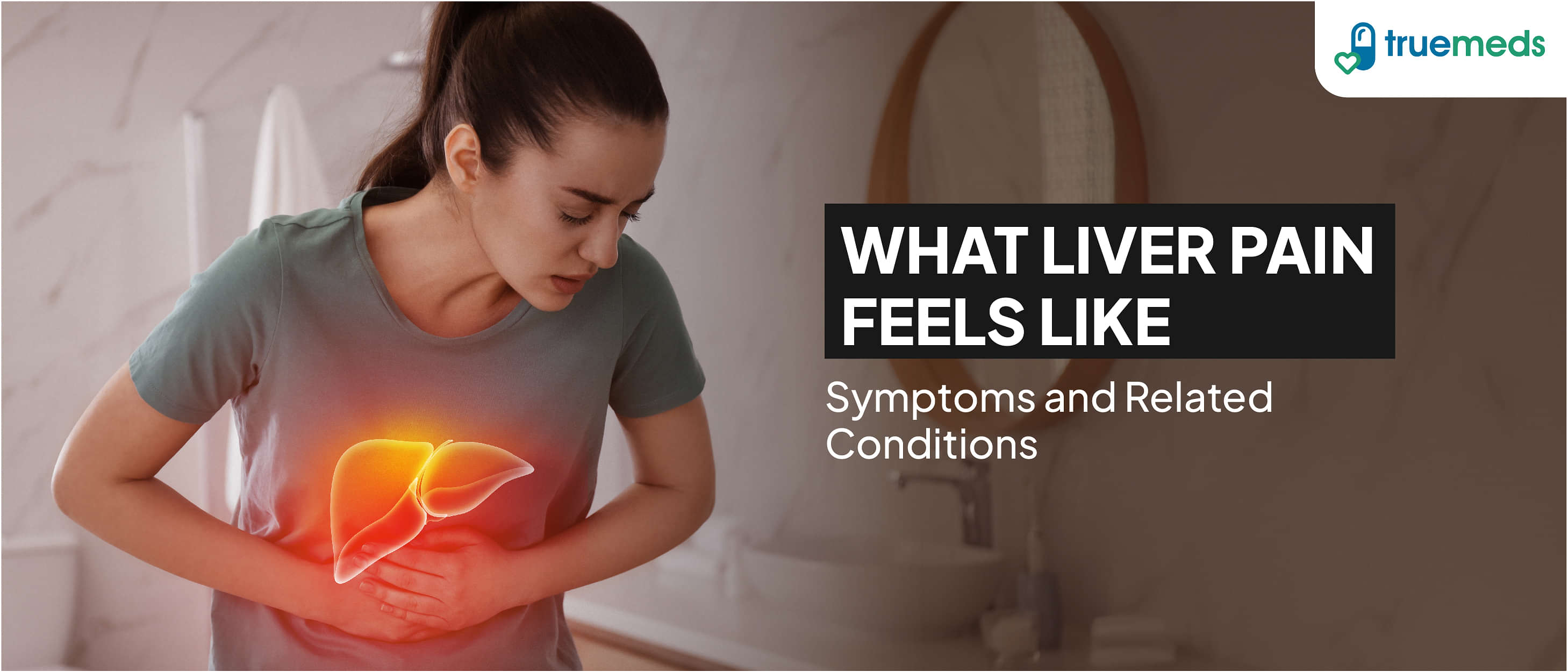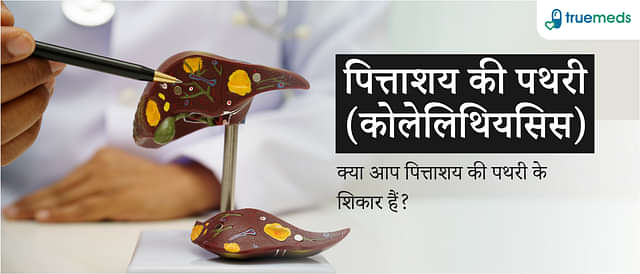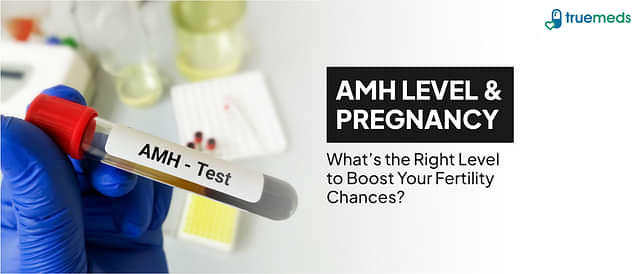Understanding Liver Pain: Causes, Symptoms, and Treatment Options
Last updated on : 01 Dec, 2025
Read time : 12 min
Liver pain often indicates that the liver is under stress or affected by an underlying condition. Located in the upper right abdomen, the liver plays a vital role in digestion, detoxification, and metabolism. When something goes wrong, it may manifest as pain or discomfort.
This guide, reviewed by a specialist in hepatology and metabolic disorders, explores the causes, symptoms, risk factors, and evidence-based treatment options for liver pain, helping you understand when to seek medical attention.
Common Symptoms Associated with Liver Discomfort
Liver discomfort can be elusive, with its exact location often challenging to pinpoint. Here is a list of common symptoms related to liver pain:
- Abdominal Pain: Liver pain is typically identified as a dull, throbbing sensation in the upper right quadrant of the abdomen, below the ribs [1]. The pain can vary from constant to intermittent and may become severe with movement or deep breathing. This discomfort often arises because the liver capsule (Glisson’s capsule) is stretched due to inflammation or swelling.
- Pain in the Right Shoulder (Referred Pain): Some people may experience referred pain, where discomfort from the liver is felt in the right shoulder. This happens because of shared nerve pathways (specifically the phrenic nerve) between the liver and the right shoulder. Any inflammation or irritation in the liver may trigger pain signals in the shoulder area.
- Additional Symptoms to Consider: Apart from abdominal and shoulder pain, liver pain may also be accompanied by other symptoms such as:
- Nausea and vomiting
- Loss of appetite
- Fatigue
- Jaundice (a condition that causes yellowing of the skin and the whites of the eyes)
- Dark urine
- Pale or clay-coloured stools
- Swelling in the legs or abdomen (ascites)
What Causes Pain in the Liver Region?
The root causes of liver pain are diverse, ranging from acute infections to chronic conditions:
1. Infections Affecting the Liver: One common cause of liver pain is infections in the liver. For example, viral hepatitis (hepatitis A, B, and C) can cause inflammation (hepatitis), leading to liver pain [2]. Hepatitis infections can be transmitted through contaminated water, food, or blood, depending on the viral type. Bacterial, fungal, or parasitic infections may also cause liver inflammation and pain, sometimes forming a liver abscess.
2. Chronic Liver Disease: Conditions that lead to long-term damage are frequent causes of chronic pain or discomfort:
- Cirrhosis: This is a late-stage liver disease in which healthy liver tissue is replaced with scar tissue, disrupting the liver’s normal functioning [1]. It is important to note that cirrhosis itself often does not cause pain until it is advanced or complicated by swelling.
- Non-Alcoholic Fatty Liver Disease (NAFLD) / Metabolic Dysfunction-Associated Steatotic Liver Disease (MASLD): This involves fat accumulation in liver cells, which may lead to inflammation and discomfort, especially if the disease progresses to Non-Alcoholic Steatohepatitis (NASH) [3]. As many as 1 in 3 adults globally are estimated to have NAFLD [4].
3. Immune System Abnormalities: Our immune system is a complex network that defends our body against harmful invaders. But sometimes, it can go wrong and attack our own cells. Autoimmune disorders, such as primary biliary cholangitis and primary sclerosing cholangitis, are conditions in which the immune system mistakenly attacks the liver’s bile ducts, leading to inflammation and resultant pain.
4. Genetic Conditions: Some genetic conditions can also lead to persistent liver pain. Hereditary Hemochromatosis, for example, is when the body absorbs too much iron from our food. The excess iron gets stored in vital organs, including the liver, causing inflammation and pain [5]. Similarly, Wilson’s disease prevents the body from removing extra copper, leading to its accumulation in the liver, causing damage and pain.
5. Cancer and Liver-Related Growths: Cancerous growths or tumours in the liver can be another causative factor for liver pain. These may include hepatocellular carcinoma (the most common type of liver cancer), cholangiocarcinoma (a rare cancer affecting the bile ducts within the liver), or metastatic liver cancer, which originates at other sites and spreads to the liver. These conditions can cause significant discomfort and pain.
6. Trauma or Injury to the Liver: Any kind of physical trauma or injury to the liver can result in acute, severe pain, requiring immediate medical attention.
Risk Factors for Liver Problems and Prevention Strategies
Various factors may amplify your risk of developing liver problems [6]. These factors comprise:
- Excessive or Habitual consumption of alcohol
- Obesity and a lifestyle lacking physical activity
- Type 2 Diabetes and insulin resistance
- Contracting a viral hepatitis infection (especially Hepatitis B and C)
- Exposure to harmful toxins or chemicals
- Inherited family history of liver disease
To lower the likelihood of developing liver issues, it is crucial to lead a healthy lifestyle. This entails:
- Sustaining a healthy weight (aiming for a Body Mass Index, or BMI, below 25 kg/m$^2$)
- Efficient management of Type 2 Diabetes and other existing health conditions
- Reducing exposure to harmful toxins and chemicals
- Observing good hygiene practices and safe intercourse to prevent the contraction of viral hepatitis.
- Getting vaccinated against Hepatitis A and B, if recommended by your doctor.
Lifestyle Adjustments to Support Liver Health
In addition to minimising risk factors, several lifestyle adjustments can promote better liver health and potentially relieve mild, non-pathological discomfort. These include:
- Consuming a balanced diet rich in nutrients (such as the Mediterranean diet, focusing on whole grains, lean proteins, fruits, and vegetables)
- Ensuring you stay hydrated by drinking ample amounts of water
- Regular exercise (at least 150 minutes of moderate-intensity activity per week) to maintain a healthy weight [3]
- Avoiding excess alcohol consumption or abstaining entirely, especially if liver damage is already present
- Quitting smoking
- Managing stress through relaxation techniques like meditation or yoga.
When to Seek Immediate Medical Help
While mild, temporary discomfort can occur, some indications suggest that you need to consult your family doctor immediately or seek emergency care [2]:
- Severe, debilitating, or sudden abdominal pain
- Yellowing of skin and eyes (Jaundice)
- Unexplained weight loss
- Persistent fever or chills
- Vomiting blood or passing black, tarry stools
- Significant, rapid swelling in the abdomen (ascites)
How Liver Conditions Are Diagnosed
If you are experiencing symptoms suggestive of a liver issue, your doctor will perform a physical examination and likely order a series of tests to determine the cause. This may include [2]:
- Blood Tests: Performed to check liver function (Liver Function Tests or LFTs) and screen for illnesses like viral hepatitis, autoimmune markers, or other infections that could be causing the pain.
- Imaging Tests: Such as ultrasound, CT scan, or MRI, help doctors look for abnormalities in the liver, such as growths, tumours, or changes in texture indicative of fibrosis or cirrhosis. FibroScan (transient elastography) is also commonly used to non-invasively assess liver stiffness.
- Liver Biopsy: This is a procedure where a small sample of liver tissue is taken for detailed analysis under a microscope, often considered the “gold standard” for staging the severity of liver disease.
- Endoscopic Retrograde Cholangiopancreatography (ERCP): A specialised endoscopic procedure used to examine and potentially treat issues in the bile ducts.
Evidence-Based Medical Treatments for Liver Conditions
If your liver pain is caused by an underlying condition, treatment is targeted at the root cause [1]. Treatment options may involve:
- Antiviral Medications: Used to treat chronic viral hepatitis B or C.
- Immunosuppressant Drugs: Used to manage autoimmune liver diseases like autoimmune hepatitis or primary biliary cholangitis.
- Phlebotomy (blood removal): Used to treat iron overload in Hemochromatosis.
- Surgery or Other Interventional Procedures: To remove tumours or growths, or to address blockages in the bile ducts.
- Liver Transplantation: Indicated in cases of severe, irreversible liver failure where other medical treatments have failed.
Caution on Natural Remedies for Liver Discomfort
It is essential to consult a healthcare professional for persistent or severe liver pain, as relying solely on home remedies can delay a critical diagnosis. While some natural products have been studied for liver support, they should never replace conventional medical treatment for diagnosed liver disease.
- Turmeric/Curcumin: Turmeric’s active compound, curcumin, has demonstrated anti-inflammatory and antioxidant properties in some studies, which theoretically could reduce liver inflammation [7]. However, the optimal dosage and efficacy in human liver disease remain under investigation.
- Milk Thistle (Silymarin): Milk thistle supplements are often used to promote liver health. Silymarin, its main active component, is a known antioxidant and may have a protective effect against liver toxins [8]. While promising, more large-scale human trials are needed to confirm its therapeutic role in specific liver conditions.
- Dandelion (Taraxacum officinale): Some preclinical studies suggest that Dandelion root extract may have protective effects in liver injury models [9]. Clinical evidence of its benefit for human liver pain or disease is currently limited.
- Dietary Adjustments: A diet rich in leafy greens, like spinach and kale, is unequivocally beneficial for overall health and supports the liver’s function by providing essential nutrients and antioxidants.
Takeaway
Experiencing liver discomfort can be concerning and sometimes significantly affect your daily life. By understanding the potential causes, symptoms, and risk factors for liver pain, you can take proactive steps toward maintaining good liver health. The key is early detection and management.
If you are dealing with persistent or severe liver pain, it is crucial to consult with a specialist, such as a gastroenterologist or hepatologist, for a proper diagnosis and evidence-based treatment plan. Prompt attention and action are vital to managing and overcoming liver discomfort.
Expert Insight
“Liver pain is usually always an indication of an underlying liver disorder like fatty liver, cirrhosis, or hepatitis. Early diagnosis and a lifestyle approach to management are key to effective outcomes. Never ignore persistent discomfort in the upper right abdomen.”
– Dr Lakshmi Vaswani
Frequently Asked Questions (FAQs)
Where is liver pain mostly felt?
Liver pain is typically felt as a dull ache or throbbing sensation in the upper right quadrant of your abdomen, beneath the lower ribs. It may sometimes radiate to the back or the right shoulder.
What pain can be mistaken for liver pain?
Pain from other organs in the same area, such as gallbladder problems (like gallstones) or stomach issues (like peptic ulcers), can mimic liver pain symptoms and cause similar discomfort in the upper right abdomen.
How do you know if your back pain is liver-related?
If back pain is accompanied by other specific liver symptoms such as jaundice (yellowing of eyes/skin), dark urine, pale stools, severe fatigue, or unexplained weight loss, it could be liver-related and warrants immediate investigation.
What does fatty liver pain feel like?
Fatty liver disease (MASLD/NAFLD) often causes no pain, but when it does, it can feel like a dull, persistent ache or fullness in the upper right abdomen, typically due to the liver swelling and stretching its capsule.
What are some common causes of liver pain?
Numerous factors, such as viral hepatitis, alcoholic hepatitis, non-alcoholic fatty liver disease (NAFLD/MASLD), cirrhosis, liver abscess, or liver cancer can cause liver pain.
What are some possible liver pain treatment options?
Liver pain treatment varies depending on the underlying cause. It may include lifestyle modifications (diet and exercise), antiviral or immunosuppressant medication, surgery, or liver transplantation for severe disease.
How is fatty liver pain treated?
Fatty liver pain is primarily treated by addressing the underlying condition, which typically involves significant dietary modifications, weight loss, and regular exercise to reduce fat in the liver and improve overall health. Specific medications may be used to manage associated conditions like Type 2 Diabetes.
References
[1] Klinge, M., Coppler, T., Liebschutz, J. M., Dugum, M., Wassan, A., DiMartini, A., & Rogal, S. (2018). The Assessment and Management of Pain in Cirrhosis. Current Hepatology Reports, 17(1), 42–51. https://doi.org/10.1007/s11901-018-0389-7
[2] Hamilton, J. P. (2023). Pain Management in Liver Disease. Gastroenterology & Hepatology, 19(6), 355–358. https://www.ncbi.nlm.nih.gov/pmc/articles/PMC10496264
[3] Vucic, A. R., & Stojicevic, M. (2021). Non-alcoholic fatty liver disease—From pathology to treatment: A focus on pharmacological therapy. World Journal of Gastroenterology, 27(31), 5122–5144. https://doi.org/10.3748/wjg.v27.i31.5122
[4] Rinella, M. E., Sanyal, A. J., & The Global NAFLD/NASH Burden. (2018). Nonalcoholic Fatty Liver Disease: A Disease of the 21st Century. Hepatology, 67(1), 1–3. https://doi.org/10.1002/hep.29528 (Used for NAFLD/MASLD prevalence statistic)
[5] NHS. (2019). Overview – Haemochromatosis. NHS. https://www.nhs.uk/conditions/haemochromatosis/
[6] (PDF) LIVER DISEASES-AN OVERVIEW. (n.d.). ResearchGate. https://www.researchgate.net/publication/331816198_LIVER_DISEASES-AN_OVERVIEW
[7] Nabavi, S. M., et al. (2018). Curcumin, a natural polyphenol with anti-inflammatory, anti-oxidant, and anti-cancer properties. Cancer Prevention Research, 11(1), 5–15. https://doi.org/10.1158/1940-6207.CAPR-17-0248
[8] Kołota, A., & Głąbska, D. (2021). Dietary Intake of Milk Thistle Seeds as a Source of Silymarin and Its Influence on the Lipid Parameters in Nonalcoholic Fatty Liver Disease Patients. Applied Sciences, 11(13), 5836. https://doi.org/10.3390/app11135836
[9] Pfingstgraf, I. O., Taulescu, M., Pop, R. M., Orăsan, R., Vlase, L., Uifalean, A., Todea, D., Alexescu, T., Toma, C., & Pârvu, A. E. (2021). Protective Effects of Taraxacum officinale L. (Dandelion) Root Extract in Experimental Acute on Chronic Liver Failure. Antioxidants (Basel, Switzerland), 10(4). https://doi.org/10.3390/antiox10040504
Disclaimer
Our healthcare experts have carefully reviewed and compiled the information presented here to ensure accuracy and trustworthiness. It is important to note that this information serves as a general overview of the topic and is for informational purposes only. It is not intended to diagnose, prevent, or cure any health problem. This page does not establish a doctor-patient relationship, nor does it replace the advice or consultation of a registered medical practitioner. We recommend seeking guidance from your registered medical practitioner for any questions or concerns regarding your medical condition.
Popular Articles
Recommended Articles
Recent Articles
Company
About UsHealth ArticleHealth StoriesHealth LibraryDiseases & Health ConditionsAyurvedaAll MedicinesAll BrandsNeed HelpFAQSecuritySubscribe
Registered Office Address
Grievance Officer
Download Truemeds
Contact Us
Our customer representative team is available 7 days a week from 9 am - 9 pm.
v4.8.2
2025 - Truemeds | All rights reserved. Our content is for informational purposes only. See additional information.
Our Payment Partners












































